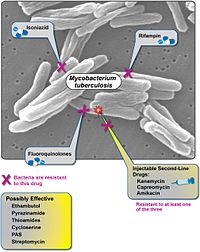
Photo from wikipedia
ABSTRACT Polymyxins are increasingly used as a last-resort class of antibiotics against extensively drug-resistant (XDR) Gram-negative bacteria. However, resistance to polymyxins can emerge with monotherapy. As nephrotoxicity is the major… Click to show full abstract
ABSTRACT Polymyxins are increasingly used as a last-resort class of antibiotics against extensively drug-resistant (XDR) Gram-negative bacteria. However, resistance to polymyxins can emerge with monotherapy. As nephrotoxicity is the major dose-limiting factor for polymyxin monotherapy, dose escalation to suppress the emergence of polymyxin resistance is not a viable option. Therefore, novel approaches are needed to preserve this last-line class of antibiotics. This study aimed to investigate the antimicrobial synergy of polymyxin B combined with enrofloxacin against Pseudomonas aeruginosa. Static time-kill studies were conducted over 24 h with polymyxin B (1 to 4 mg/liter) and enrofloxacin (1 to 4 mg/liter) alone or in combination. Additionally, in vitro one-compartment model (IVM) and hollow-fiber infection model (HFIM) experiments were performed against P. aeruginosa 12196. Polymyxin B and enrofloxacin in monotherapy were ineffective against all of the P. aeruginosa isolates examined, whereas polymyxin B-enrofloxacin in combination was synergistic against P. aeruginosa, with ≥2 to 4 log10 kill at 24 h in the static time-kill studies. In both IVM and HFIM, the combination was synergistic, and the bacterial counting values were below the limit of quantification on day 5 in the HFIM. A population analysis profile indicated that the combination inhibited the emergence of polymyxin resistance in P. aeruginosa 12196. The mechanism-based modeling suggests that the synergistic killing is a result of the combination of mechanistic and subpopulation synergy. Overall, this is the first preclinical study to demonstrate that the polymyxin-enrofloxacin combination is of considerable utility for the treatment of XDR P. aeruginosa infections and warrants future clinical evaluations.
Journal Title: Antimicrobial Agents and Chemotherapy
Year Published: 2018
Link to full text (if available)
Share on Social Media: Sign Up to like & get
recommendations!